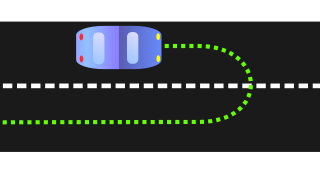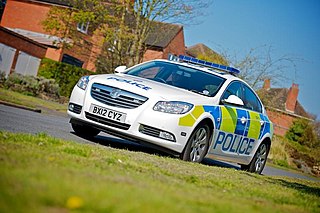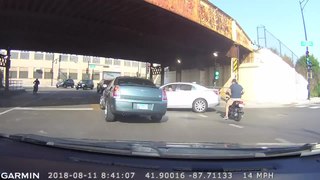
Traffic on roads consists of road users including pedestrians, ridden or herded animals, vehicles, streetcars, buses and other conveyances, either singly or together, while using the public way for purposes of travel.

Traffic lights, traffic signals, stoplights or robots are signalling devices positioned at road intersections, pedestrian crossings, and other locations to control flows of traffic.

A level crossing is an intersection where a railway line crosses a road or path, or in rare situations an airport runway, at the same level, as opposed to the railway line crossing over or under using an overpass or tunnel. The term also applies when a light rail line with separate right-of-way or reserved track crosses a road in the same fashion. Other names include railway level crossing, railway crossing, railroad crossing, grade crossing, road through railroad, criss-cross, train crossing, and RXR (abbreviated).

Road traffic safety refers to the methods and measures used to prevent road users from being killed or seriously injured. Typical road users include pedestrians, cyclists, motorists, vehicle passengers, horse riders, and passengers of on-road public transport.

Jaywalking is a term, originating in the United States, for pedestrians walking in or crossing a roadway that has traffic, other than at a suitable crossing point, or otherwise in disregard of traffic rules. The term originated with jay-drivers, people who drove horse-drawn carriages and automobiles on the wrong side of the road, before taking its current meaning.

A U-turn in driving refers to performing a 180° rotation to reverse the direction of travel. It is called a "U-turn" because the maneuver looks like the letter U. In some areas, the maneuver is illegal, while in others, it is treated as a more ordinary turn, merely extended. In still other areas, lanes are occasionally marked "U-turn permitted" or even "U-turn only."
The Road Traffic Safety Law of the People's Republic of China is a law which was passed by the Standing Committee of the National People's Congress of the People's Republic of China on October 28, 2003, promulgated by Decree No. 8 of the President of the PRC Hu Jintao, and took effect on May 1, 2004, on all parts of mainland China It is the People's Republic of China's first-ever law on road traffic safety, and was intended to address an alarmingly high traffic fatality rate, which is four or five times greater than other nations.

A police car is a ground vehicle used by police for transportation during patrols and to enable them to respond to incidents and chases. Typical uses of a police car include transporting officers so they can reach the scene of an incident quickly, transporting and temporarily detaining suspects in the back seats, as a location to use their police radio or laptop, or to patrol an area, all while providing a visible deterrent to crime. Some police cars are specially adapted for certain locations or for certain operations. Police cars typically have rooftop flashing lights, a siren, and emblems or markings indicating that the vehicle is a police car. Some police cars may have reinforced bumpers and alley lights, for illuminating darkened alleys.
A crossing guard, lollipop man/lady, crosswalk attendant, or school road patrol is a traffic management personnel who is normally stationed on busy roadways to aid pedestrians. Often associated with elementary school children, crossing guards stop the flow of traffic so pedestrians may cross an intersection. Crossing guards are known by a variety of names, the most widely used in the United Kingdom, Ireland and Australia being "lollipop lady/man", a reference to the large signs used that resemble lollipops. The verb is lollipopping, which can also be used for road works.

A turn on red is a principle of law permitting vehicles at a traffic light showing a red signal to turn into the direction of traffic nearer to them when the way is clear, without having to wait for a green signal. North American traffic engineers first introduced this rule as a fuel savings measure, however various studies find that it increases the risk of collisions between vehicles and pedestrians.
Road signs in Singapore closely follow those laid down in the traffic sign regulations used in the United Kingdom, although a number of changes over the years have introduced some slight deviations that suit local road conditions. Road signs in Singapore conform to the local Highway Code under the authority of the Singapore Traffic Police.
Driving in the United Kingdom is governed by various legal powers and in some cases is subject to the passing of a driving test. The government produces a Highway Code that details the requirements for all road users, including drivers. Unlike most other countries in the world, UK traffic drives on the left.

The Driving License of the People's Republic of China is the legal driving license within China excluding the two special administrative regions. In these two territories separate driving license must be obtained from their respective traffic authorities. It is issued, ratified and regularly inspected by the traffic administrative department of the public security organ. Minimum age varies from 18 all the way up to 26 in the country.
A slip lane or slip road is a road at a junction that allows people to change roads without actually entering an intersection. They are primary seen at the junction of two busy roads, as an entrance to a busy highway such as a dual carriageway and are the only means to join a motorway.

A box junction is a road traffic control measure designed to prevent congestion and gridlock at junctions. The surface of the junction is typically marked with a yellow criss-cross grid of diagonal painted lines, and vehicles may not enter the area so marked unless their exit from the junction is clear, or they are intending to turn and are prevented from doing so by oncoming traffic, or other vehicles on the box waiting to turn.

In Japan, road signs are standardized by the "Order on Road Sign, Road Line, and Road Surface Marking (道路標識、区画線及び道路標示に関する命令)" established in 1968 with origins from the Tokyo Metropolitan Police Department's "Order on Standardization of Road Sign" of 1934 and the Home Ministry of Japan's "Order on Road Signs" of 1942. The previous designs have been used since 1986 after several amendments of order.

In traffic laws, a hit and run or a hit-and-run is the act of causing a traffic collision and not stopping afterwards. It is considered a supplemental crime in most jurisdictions.

Two-wheelers are a common sight and widely used in Japan. Of these, bicycles and scooters are the most common.

Driving in India is governed by various legal powers and in some cases is subject to the passing of a driving test. The Ministry of Road Transport and Highways, a branch of the Government of India, is the apex body for formulation and administration of the rules, regulations and laws relating to road transport, national highways and transport research, in order to increase the mobility and efficiency of the road transport system in India. Indian traffic drives on the left.

Terminology related to road transport—the transport of passengers or goods on paved routes between places—is diverse, with variation between dialects of English. There may also be regional differences within a single country, and some terms differ based on the side of the road traffic drives on. This glossary is an alphabetical listing of road transport terms.














